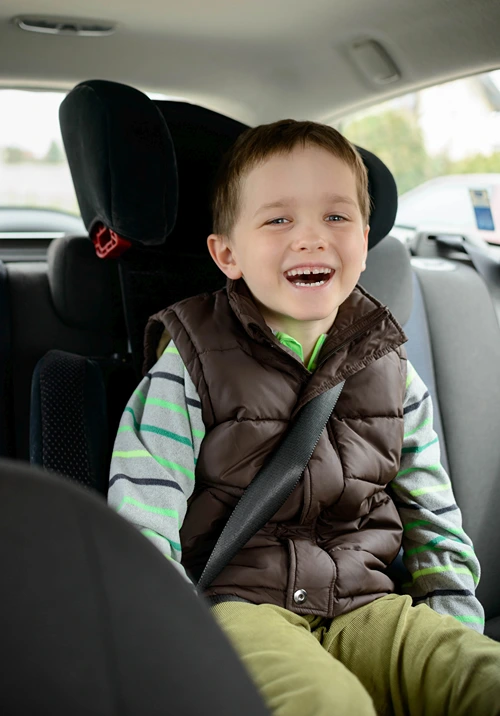How to Make Your Car Safer for Children with Special Needs
You’ve packed the snacks, queued up the road trip playlist, and double-checked everything. But your youngest has special needs, and the drive may bring more than just traffic delays. Children with special needs experience the world differently and need more than just a seatbelt. Is your car safe for your child?
Road Safety Challenges for Children with Special Needs
Children with special needs encounter specific road safety challenges that demand customized approaches to keep them safe during car rides.
One frequent challenge is the tendency for some children to unbuckle their seatbelts or harnesses. This is especially common among children with Autism Spectrum Disorder (ASD), who may struggle with communication and therefore have difficulty understanding why staying buckled is important.
Sensory processing issues, often present in ASD, can also make wearing a seatbelt uncomfortable, increasing their resistance to keeping it on.
Besides unbuckling, these children might display disruptive behaviors such as kicking the back of seats, disturbing the driver or passengers, opening doors while the vehicle moves, head banging, self-hitting, breath-holding, or rocking so intensely that seatbelts leave marks.
These actions pose serious safety risks and often require specially designed harnesses, seats, or protective vests to secure the child properly.
Physical limitations further complicate safety concerns. Children with poor motor control or other physical challenges may find regular car seats unsuitable. They need seats that offer enhanced support to help maintain proper posture and prevent unsafe movements during travel.
Tips to Make Your Car Safer for Children with Special Needs
If your child has autism or a medical condition, they may need extra support while in the car. You might need essential things to keep in the car to manage their comfort, safety, and needs throughout the trip.
Whether you’re heading out for a holiday visit, a family vacation, or a long road trip, here are some helpful tips to keep your child with special needs safe on the road:
Choose the Right Medical Car Seat Option
Some children need specially adapted car seats to meet their unique physical and behavioral needs. Unlike standard seats, these customized options offer features that enhance safety and comfort. A five-point harness, adjustable padding, footrests, and lateral supports work together to maintain proper posture and reduce fatigue.
Make Sure the Car Seat Is Installed Correctly
The car seat should be firmly installed and fully latched for maximum safety. Carefully review both the car seat’s instructions and your vehicle’s owner’s manual to correctly use either the lower anchors or the seat belt, but never both together.
Many car seats feature built-in angle indicators to guarantee the proper recline for rear-facing seats. If unsure about installation, consult certified Child Passenger Safety Technicians (CPSTs) for professional assistance.
Ensure Electrical Equipment Has Power for Twice the Expected Trip Time
Ensuring enough power for electrical devices is important for children with special needs. Benioff Children’s Hospital Oakland advises using portable power lasting twice the trip’s duration to cover delays and keep devices running.
For example, a backup power source is necessary if you use a continuous positive airway pressure (CPAP) machine or other medical equipment, especially on long trips or in areas with limited power access.
Choose the Backseat
Consider back seats with features or modifications specifically designed for children with special needs. Some seats offer a tilt-back function that supports children with difficulty holding their heads upright. Others include swivel bases that rotate the seat toward the door, making transferring the child in and out of the car safer and more convenient.
Use Restraint with a Higher-Weight Harness
Higher-weight harnesses provide extra support and stability for children beyond standard harnesses’ weight or height limits. Moreover, they are beneficial for children with conditions such as autism, postural instability, or muscular and functional limitations that affect their ability to maintain proper posture or control their movements.
Never Use Rear-Facing Seats in the Front Seat
Always place your child in the back seat. It’s the safest spot during any trip. Never install a car seat, especially a rear-facing one, in the front seat. Airbags in the front can cause serious injuries in a crash.
Install Belt-Removal Alarms
Belt-removal alarms detect when a seatbelt is unbuckled and immediately alert you with a loud sound. This prevents unsafe behaviors and potential injuries and helps make sure your child stays securely restrained throughout the trip.
Equipped with sensitive sensors built into the buckle, the system triggers the sound the moment it’s released, allowing you to respond quickly and maintain constant supervision.
Use In-Car Cameras
In-car cameras allow you to monitor your child in real time without turning around or getting distracted while driving. Rear-facing cameras connected to a dashboard or mirror-mounted screen let you observe behaviors, physical needs, or signs of distress.
For instance, reviewing footage can reveal whether certain sounds, lighting, or trip lengths cause discomfort or meltdowns.
Control Interior Temperature and Lighting
You should maintain a comfortable interior environment, as your child may be more sensitive to temperature changes or lighting.
Use sunshades, tinted windows, or climate control settings to regulate heat and cold. Soft lighting or dimmable interior lights can reduce sensory overload and help keep your child calm throughout the trip.
Have a Car Safety Care Plan
Make a car safety plan for your child in case of a medical emergency while driving. If possible, have a tag with your child’s diagnosis and important info for emergency workers. Include how your child communicates, such as nonverbal, sign language, or the Pragmatic Organization Dynamic Display (PODD) system.
List medications with times and quantities, feeding needs, such as allergies and feeding tube details, and your pediatrician’s name and phone number.
Tie Down Wheelchairs, Oxygen Tanks, or Feeding Pumps
Secure all equipment using proper tie-downs or restraint systems before every trip. Unsecured items can turn into dangerous projectiles during sudden stops or collisions.
You can use four-point straps for wheelchairs, cylinder holders for oxygen tanks, or stable brackets for pumps. Always double-check that everything is locked in place to reduce injury risk and ensure a safer ride.
Final Thoughts
Every trip holds the promise of memories, but for a child with special needs, safety must come first. You need to make your car meet the unique challenges of children with special needs to make every mile feel safer, calmer, and more possible for the one who needs it most.






